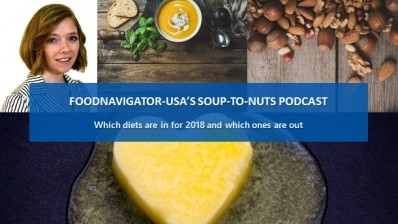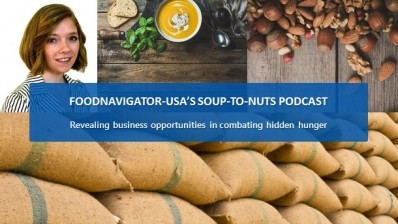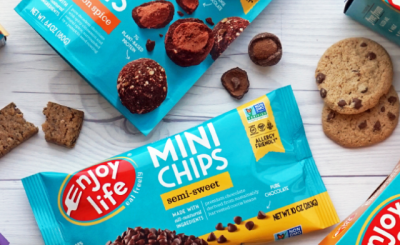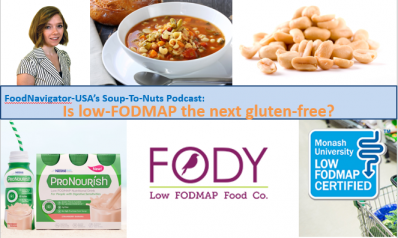Soup-To-Nuts Podcast: Where to next for the $6.5B ‘free-from’ category?
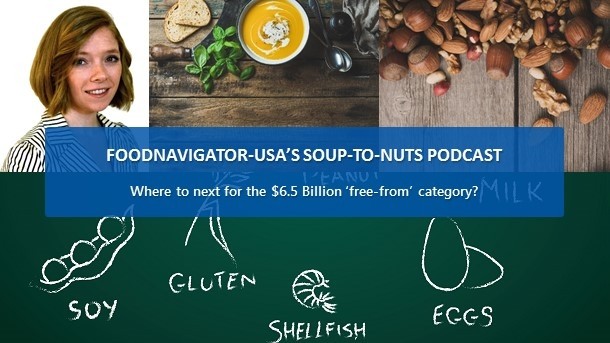
A FAIR Health study published late this summer suggests that food allergies are a growing national public health concern based on its finding that insurance claims filed for severe allergic reactions to food increased a whopping 377% from 2007 to 2016. This is on top of previously released data from the Centers for Disease Control and Prevention that found the prevalence of food allergies among children increased 18% from 1997 to 2007, and a study of emergency room visits and hospital admissions of children in Illinois that found admissions due to anaphylaxis triggered by food increased 29.1% from 2008 to 2012.
To help meet the needs of the more than 75 million Americans affected either directly or indirectly from common allergens, more food and beverage manufacturers are creating a wider array of so-called free-from products, which can range from gluten-free, to allergen-free to simply non-GMO. And as they continue to innovate and gain mainstream attention, this category is projected to nearly double from today’s $6.5 billion to a whopping $12 billion by 2020.
In this episode of FoodNavigator-USA’s Soup To Nuts Podcast, Joel Warady, the chief marketing and innovation officer at Enjoy Life Foods, and Michele Abo, the CEO of Ian’s, discuss the extent of need for free-from products as well as where the trend is headed, where the market is saturated and where there is still room for growth.
“In the United States today, every three minutes of every single day, 365 days a year, someone goes to the emergency room for a food allergy related issue and every six minutes that issue is potentially anaphylactic. So, when you think about that – that it is happening every three minutes – it is much larger than people ever imagined it would be,” Warady said, setting the stage for the category’s need and potential.
Warady added that as the number of afflicted grows in the US, so too is awareness by retailers and the general population.
“When we started Enjoy Life 16 years ago, our brand promise from day one is that all of our products were gluten-free as well as free from the top eight allergens. … We had no idea what the size of the market would be and when we would talk to retailers … they just looked at us as if we had landed from Mars,” he said. But today, he added, “from a business standpoint … the free from market will be worth $12 billion, with a B, $12 billion globally within the next five years.”
But not all of this growth is coming strictly from those who have diagnosed food allergens. Warady explains the consumers driving this trend can be broken into two groups: worriers and wonderers.
The first are people who have diagnosed allergies and worry they will get sick if they eat or drink the wrong thing. The second are those who wonder if a food or ingredient is contributing to some malady in their life, such as thinning hair or sluggishness, he said.
“So, when you think about this size of the market of $12 billion for free-from products, it is not all because of people who have allergies. It is because a lot of people are making the choice to remove certain ingredients from their daily lives,” he said.
A third group of free-from consumers are those who don’t have an allergy and who don’t wonder if something they are eating is throwing some part of their body out of whack. These are people who can safely and happily eat anything. Yet, Warady explains they buy free-from products because they have loved ones who fall into one of the first two categories and they want to be supportive and simplify the shopping and cooking experience.
For this group not to feel like they are making an undo sacrifice, the free-from products they buy must taste just as good if not better than their conventional counterparts, Warady said.
“If it tastes great, not only will the person who has to eat it, enjoy it, but the rest of the people in the family will say, ‘Well, if I am going to eat a cookie or bar, I might as well eat what my child who has food allergies has to eat.’ And everyone can enjoy it,” he explained.
Being able to eat the same foods as everyone else is also extremely important to children with allergens who run the risk of being bullied for being different from their peers. According to Abo, Ian’s, which makes a variety of allergy-free frozen products, is particularly sensitive to children’s need to fit in.
“Kids are under a lot of pressure and there is all this bullying. Kids don’t want to feel different. They want to feel like part of the family, they want to feel like other kids. So, while over the years we have spoken loudly and been very true to the mission of being gluten-free and then allergy free-from, we also consider our brand really to provide healthy comfort foods that can be enjoyed by the entire family – so not just for kids, but the kids in all of us,” Abo said.
A win-win for retailers and manufacturers
By creating foods that people with and without allergies alike will enjoy, companies like Ian’s and Enjoy Life are paving the way for retailers to do away with special sections in stores dedicated to gluten-free or allergy-friendly products, which Abo says not only isolates shoppers with allergies but can limit product sales and basket size.
She explains that by putting allergy-friendly and specialty products next to conventional options, more conventional shoppers are likely to discover the brands and buy them. Likewise, free-from shoppers will be pushed to shop the entire retail store, and given they tend to fall in the top 15% of spending, they are a group that could help substantially boost retailers’ basket size.
Abo says that in the coming years Ian’s will continue to push its products, and allergen-free options in general, into the mainstream even more by working retailers in different channels. In particular, the brand is targeting the club channel, which has been influential in helping organic explode. It also is launching a new consumer campaign with an enhanced social and digital blogger influencer platform, she said.
In addition to expanding free-from products across channels and throughout retail stores, Warady and Abo also see plenty of room for new product development across categories.
One example of an area in need of innovation, to which Enjoy Life is stepping up to help fill, is the seasonal candy aisle.
“Enjoy Life has never done season products although our consumers have asked for them for years. So, for the first time this year, we created a seasonal Halloween line where we took our regular chocolate bar that is made with pure chocolate, and we molded it into single squares and the we designed Halloween packs to allow families who want to give out a safe snack at their door, a solution for that,” Warady said.
“We are going to be expanding that so that in 2018 we are also going to be doing Easter and winter holidays along with, in 2019, we will add Valentine’s Day,” he added.
Other areas still ripe for allergy-free product development are entrees and ready-to-eat chilled or frozen full meals that focus on filling the center of the place, according to both Warady and Abo.
Hand in hand with this, Warady reiterated Abo’s prediction that foodservice is ready for more allergy-free options.
Finally, Warady said even in the categories where there already is a large allergy-free presence, more brands and companies are needed to create diversity and continue to build the category. And to those that might worry that free-from is simply a fad, Warady reassures it is not and that rather it is a growing trend that is here to stay.
